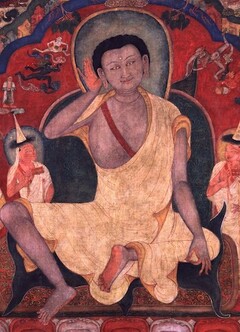Milarepa Guru Yoga
༄༅། །རྗེ་བཙུན་བཞད་པ་རྡོ་རྗེའི་བླ་མའི་རྣལ་འབྱོར་བཞུགས་སོ། །
Guru Yoga of Jetsün Shepa Dorje
by Jamyang Khyentse Chökyi Lodrö
ན་མོ་བྷཊྚ་རཱ་ཀ་ཡེ།
Namo bhaṭṭarākāya!1
མཚན་ཙམ་ཐོས་པས་ངན་འགྲོ་ཡི། །
སྡུག་བསྔལ་མཐའ་དག་སེལ་མཛད་པ། །
མི་ལ་རྗེ་ཡི་ཞབས་བཏུད་ནས། །
བླ་མའི་རྣལ་འབྱོར་ཉུང་ངུར་དབྱེ། །
The mere sound of your name is enough
To dispel the sufferings of the lower realms.
Lord Mila, bowing down at your feet,
I shall here set out a brief guru yoga.
Refuge & Bodhicitta
དེ་ལ་དང་པོ་སྐྱབས་སེམས་ནི།
First, to take refuge and generate bodhicitta:
མཁའ་མཉམ་འགྲོ་དྲུག་སེམས་ཅན་རྣམས། །
khanyam dro druk semchen nam
Sentient beings of the six classes throughout the whole of space
བླ་མ་མཆོག་ལ་སྐྱབས་སུ་མཆི། །
lama chok la kyab su chi
Take refuge in the supreme guru.
སྲིད་པའི་མཚོ་ལས་སྒྲོལ་བ་ཡི། །
sipé tso lé drolwa yi
To find freedom from the ocean of saṃsāric existence,
སྨོན་འཇུག་བྱང་ཆུབ་མཆོག་སེམས་བསྐྱེད། །
mönjuk changchub chok semkyé
I set my mind that upon supreme awakening, in aspiration and in action.
དངོས་གཞི་རྟེན་བསྐྱེད་ནི།
Main Practice
Visualization
ཨཿ རང་སྣང་དག་པའི་ཞིང་ཁམས་ཆེ། །
ah, rangnang dakpé zhingkham ché
Ah. My own perception is a vast realm of purity.
མཆོད་སྤྲིན་རྒྱ་མཚོས་བཏེགས་པའི་དབུས། །
chötrin gyatsö tekpé ü
In its centre, supported by vast clouds of offerings,
པད་དཀར་ཟླ་བ་རྒྱས་པའི་སྟེང་། །
pekar dawa gyepé teng
Upon a white lotus and full moon disc
རྣལ་འབྱོར་དབང་ཕྱུག་མི་ལ་རྗེ། །
naljor wangchuk mi la jé
Is the lord of yogis, precious Milarepa.
དཀར་སྔོ་མཛེས་འཛུམ་ལྕང་ལོ་འཕྱང་། །
kar ngo dzé dzum changlo chang
He is pale blue, handsome and smiling, with long braided locks.
ཕྱག་གཡས་སྙན་གྱི་ཐད་ཀར་གཏོད། །
chak yé nyen gyi tekar tö
His right hand is held at the level of his ear;
གཡོན་པ་ས་གནོན་པུས་སྟེང་བཀབ། །
yönpa sa nön pü teng kab
His left, in the earth-touching mudrā, covers his knee.
གཅེར་བུ་ཨང་རག་རས་གཟན་གསོལ། །
cherbu ang rak ré zen sol
He is naked but for a loincloth and cotton shawl,
ཞབས་གཉིས་ཕྱེད་སྐྱིལ་སྟབས་ཀྱིས་བཞུགས། །
zhab nyi chekyil tab kyi zhuk
And is seated with his two legs loosely crossed.
གནས་གསུམ་འབྲུ་གསུམ་འོད་འཕྲོས་པས། །
né sum dru sum ö tröpé
Light shines out from the three syllables at his three centres
ཡེ་ཤེས་སྤྱན་དྲངས་དབྱེར་མེད་གྱུར། །
yeshe chendrang yermé gyur
To invite the wisdom form, who dissolves into him indivisibly.
བླ་མ་མཆོག་ལ་བདག་སྐྱབས་མཆི། །
lama chok la dak kyab chi
I take refuge in the supreme guru.
སྡིག་པ་མི་དགེ་སོ་སོར་བཤགས། །
dikpa mi gé sosor shak
I confess my misdeeds and harmful actions, one by one.
སོགས་རྒྱུན་བཤགས་བྱ། སྤྲོ་ན་མཎྜལ་ཕུལ།
Continue with the daily confession practice. Should you wish to practise more elaborately, offer the maṇḍala.
རྗེ་དྲན་པ་ཙམ་གྱིས་གདུང་བ་སེལ། །
jé drenpa tsam gyi dungwa sel
Precious lord, merely to remember you banishes all ills.
སྲིད་ཞིའི་རྒུད་པ་སྐྱོབ་མཛད་པ། །
sizhi güpa kyob dzepa
You who save from the strains of existence and quiescence,
བཞད་པ་རྡོ་རྗེར་གསོལ་བ་འདེབས། །
zhepa dorjér solwa deb
Shepa Dorje, to you I pray:
རྟག་ཏུ་བདག་ལ་བྱིན་གྱིས་རློབས། །
taktu dak la jingyi lob
Always inspire me with your blessings,
མཆོག་དང་ཐུན་མོང་དངོས་གྲུབ་སྩོལ། །
chok dang tünmong ngödrub tsol
And bestow supreme and ordinary attainments.
ཞེས་དང་།
Mantra Recitation
ཨོཾ་ཨཱཿགུ་རུ་ཧ་སྱཱ་བཛྲ་སརྦ་སིདྡྷི་ཧཱུྃ།
om ah guru hasya benza sarwa siddhi hung
oṃ āḥ guru hāsya vajra sarva siddhi hūṃ2
ཅི་ནུས་བཟླ།
Recite the mantra as many times as you can.
དཔལ་ལྡན་རྣལ་འབྱོར་དབང་ཕྱུག །
palden naljor wangchuk
Glorious guru, lord of yogins,
དྲན་མཆོག་བཞད་པ་རྡོ་རྗེ། །
dren chok zhepa dorjé
Supreme object of recollection Shepa Dorje,
རྗེ་བཙུན་ཐོས་པ་དགའ་བར། །
jetsün töpa gawar
Venerable Töpa Ga, ‘Joyous to Hear’,
རྩེ་གཅིག་གསོལ་བ་འདེབས་ན། །
tsechik solwa deb na
As I pray to you single-pointedly,
བྱིན་རླབས་དབང་བསྐུར་སྩོལ་ཅིག །
jinlab wangkur tsol chik
Inspire me with your blessings and grant empowerment.
བླ་མའི་གསང་གསུམ་འོད་ཟེར་ལས། །
lamé sang sum özer lé
From the light rays at the guru's three secrets,
ཨོཾ་ཨཱཿཧཱུྃ་དང་སྭཱ་ཧཱ་འཕྲོས། །
om ah hung dang soha trö
The syllables oṃ, āḥ, hūṃ and svāhā emerge
རང་གི་གནས་བཞིར་ཐིམ་པ་ལས།
rang gi né zhir timpa lé
And dissolve into my own four centres,
སྒྲིབ་དག་དབང་དང་དངོས་གྲུབ་ཐོབ། །
drib dak wang dang ngödrub tob
Purifying obscurations and conferring empowerment and siddhis.
སྐུ་བཞིའི་ས་བོན་རྒྱུད་ལ་བཞག །
ku zhi sabön gyü la zhak
The seeds of the four kāyas are implanted in my mindstream.
བླ་མ་རང་ཐིམ་དབྱེར་མེད་ངང་། །
lama rang tim yermé ngang
The guru dissolves into me, inseparably.
མ་བཅོས་རང་བབས་ཕྱག་རྒྱ་ཆེ། །
machö rangbab chakgya ché
And I rest in that natural and unaltered state of Mahāmudrā.
དུས་གསུམ་དུས་མེད་རྟག་པར་སྐྱོང་། །
dü sum dümé takpar kyong
Sustaining an experience of timelessness beyond past, present and future,
སྣང་སྲིད་ཕྱག་རྒྱ་ཆེན་པོར་བལྟ། །
nangsi chakgya chenpor ta
I look into the Great Seal of appearance and existence.
ཞེས་མཉམ་པར་བཞག །
Rest in equipoise.
ཐུན་ལས་ལྡང་བ་ན། དགེ་བསྔོ་སོགས་བྱ།
When you rise from the session, dedicate the virtue and so on.
རྗེས་ཐོབ་བླ་མའི་ལམ་ཁྱེར་དང་མ་བྲལ་བར་བྱའོ། །
During the post-meditation, never fail to integrate the practice of the guru.
ཅེས་པའང་ལྭ་དཀར་བསོད་རྒྱལ་ནས་རྩེད་མོའི་ཚུལ་དུ་འདི་འདྲ་བྲིས་ཤིག་ཅེས་བསྐུལ་བས་མཚམས་སྦྱར་ཏེ། འཇམ་དབྱངས་ཆོས་ཀྱི་བློ་གྲོས་པས་མཚུར་ཕུ་སྟོད་ལུང་གི་དགོན་པ་འཇིག་རྟེན་དབང་ཕྱུག་དགྱེས་པར་རོལ་པའི་གཟིམ་ཁང་ལྷ་ཁང་རྣམ་ཐར་སྒོ་གསུམ་དུ་བྲིས་པ་འདིས་ཀྱང་བླ་མ་རྗེ་བཙུན་ཆེན་པོའི་བྱིན་བརླབ་མྱུར་དུ་འཇུག་པའི་རྒྱུར་གྱུར་ཅིག། སརྦ་དཱ་མངྒ་ལཾ།། །།
When Lakar Sogyal playfully asked me to write something of this kind, I, Jamyang Chökyi Lodrö, wrote this in the monastery of Tsurphu Tölung in the residence known as Display that Delights the Lord of the World in its Three Doors of Liberation temple. May this become a cause for the blessings of the great reverend guru to infuse us all. Sarvadā maṅgalaṃ.
| Translated by Adam Pearcey with the generous support of the Khyentse Foundation and Tertön Sogyal Trust, 2020.
'Jam dbyangs chos kyi blo gros. "rje btsun bzhad pa rdo rje'i bla ma'i rnal 'byor//" in gsung 'bum/_'jam dbyangs chos kyi blo gros/ (dbu med/). TBRC W21813. 8 vols. Gangtok: Dzongsar Khyentse Labrang, 1981–1985. http://tbrc.org/link?RID=W21813 Vol. 1: 435–437
Version: 1.3-20230127
